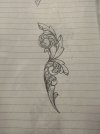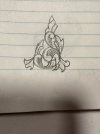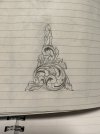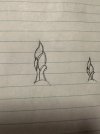- Joined
- Dec 31, 2022
- Messages
- 62
I am submitting for critique some recent drawings of scrolls. These are blendings of those I have trained under with my own vision. Not being a trained artist I would like some feedback from the group. One element, I call it a flame bud, is meant to top a triangle scroll or the ends of a center piece. I am still waiting for my tool so here is all the work I have to present for critique.
V/R Dale
V/R Dale












